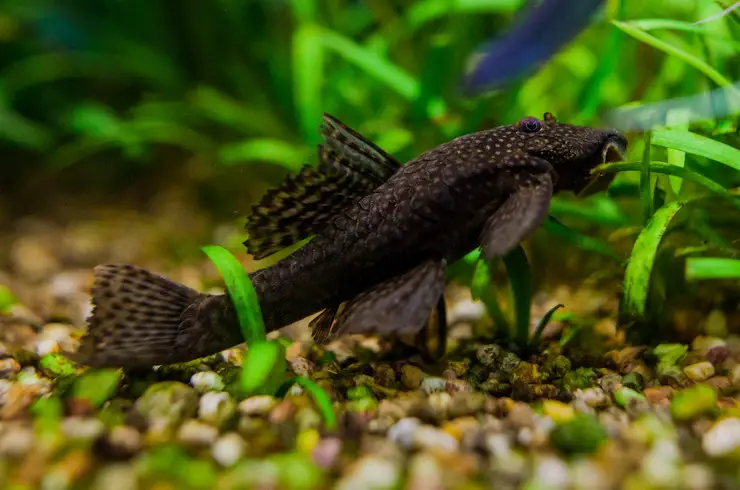Ancistrus (Ancistrus sp.) Are popular aquarium fish from the chain mail family, or loricariid catfish. The name of the family comes from the word “Lori-ka”, as the armor of legionaries was called in ancient Rome.
General information
Chain catfish also have their “armor” – the whole body is covered with accrete bone plates that protect these fish from natural enemies. The family includes both small species, several centimeters long, and giants: some pterygoplichts can reach up to 35-40 cm in length. Most of the ancistrus is peaceful and very hardy fish that will not only become an unconditional decoration of the aquarium but will also help the aquarist in the fight against algae – the favorite food of catfish.
Appearance
The body of the ancistrus catfish is drop-flattened, covered with rows of polygonal bone plates. A distinctive feature is the elongated sucker-shaped lips with horn-shaped scrapers that form the lower mouth. They allow ancistrus to stay on snags and stones in their natural habitat in reservoirs with a strong current. With the help of horn-shaped tubercles (“graters”), the fish clean off fouling from the glass of the aquarium, plant leaves, decorations, and stones, using them for food.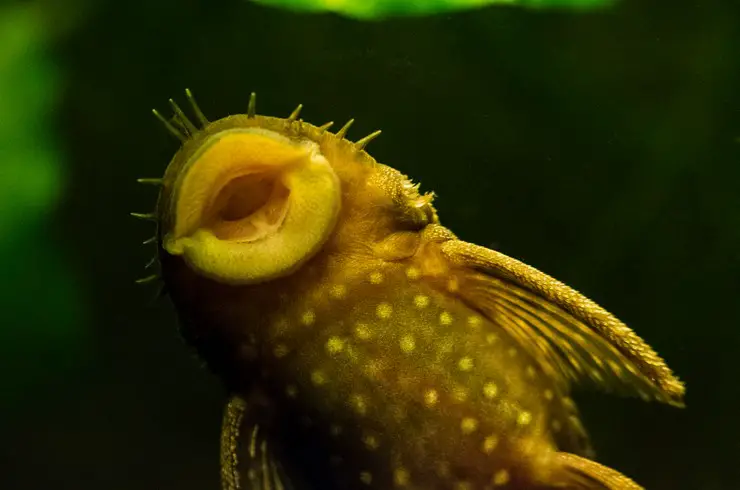
Body-color can range from light gray to dark gray, brownish, and black with light spots. These spots form streaks on the fins. The abdomen is lighter than the back. Color may fade depending on conditions. Gender dimorphism is characteristic of all types of ancistrus. However, it is possible to distinguish an ancistrus male from a female with accuracy only after reaching puberty (at the age of about 1 year, and in some species, for example, stellate ancistrus L181, only by 2 years). On the head of the catfish, tentacles are located – skin processes. In females, the processes are located at the edges of the head, they are poorly developed (no more than 1 mm) and there are very few of them, in some cases, they are completely absent. The tentacles (“whiskers”) of the male grow over the entire head, reaching a length of 1.5-2 cm, and as the fish grows, they begin to branch.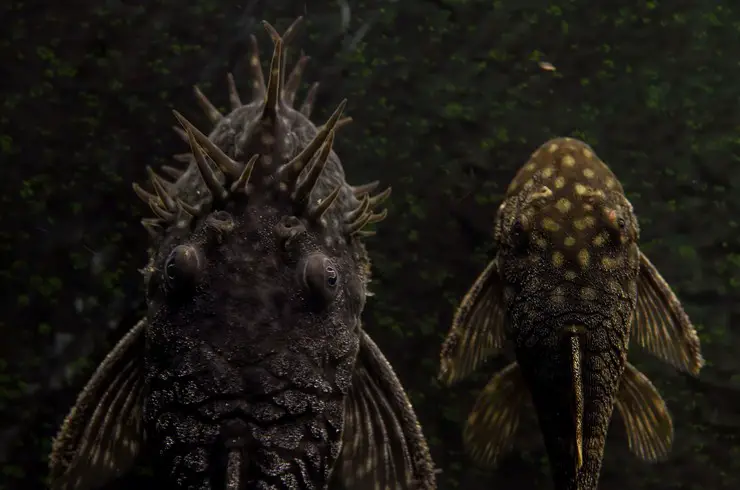
Habitat
The blue catfish-Ancistrus, or common ancistrus, in nature lives in the tributaries of the Amazon River, prefers reservoirs with a fast current. The habitat of the mustachioed catfish-Ancistrus (Ancistrus cirrhosus) also includes the eastern part of South America in the waters of the Amazon River basin, in the rivers of Guiana, Suriname, Guyana, Trinidad Island. Star ancistrus lives in the mountain rivers of South America, reservoirs in the Andes (Peru), and the upper reaches of the Orinoco River in Venezuela.
Care and maintenance
Ancistrus can be kept in almost any tropical aquarium. The recommended minimum volume is 50 liters. It is desirable that the soil has no sharp edges and is not too shallow. It is very useful to use natural driftwood as decorations: ancistrus with great pleasure scrape off their top layer and thus get cellulose, which is extremely necessary for comfortable digestion. Fish are active, mainly in the evening and at night, so it is recommended to create periods of twilight lighting every 30-40 minutes between the peaks of bright lighting. It is useful to place a large number of shelters in the aquarium, in which the catfish will hide during the day and as needed.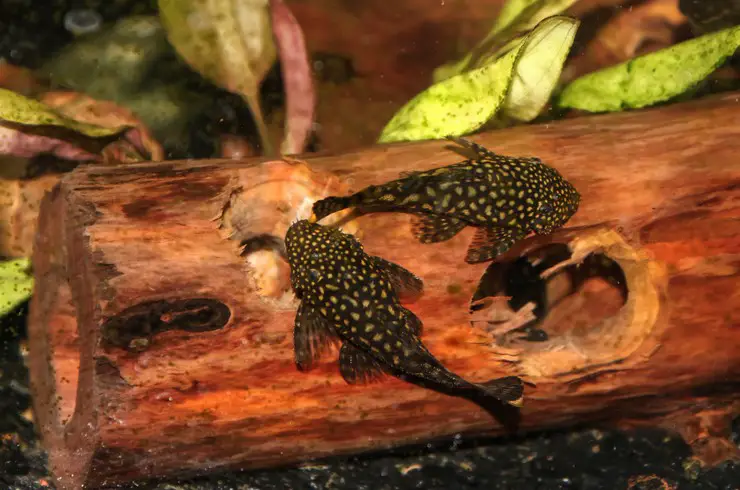
Despite their origin from South America, where the water in the rivers is predominantly soft and acidic, ancistrus have adapted to live in a wide range of parameters. Many ways to get along even with African cichlids in fairly hard and alkaline water. The most important thing is to provide the fish with good aeration and a temperature of 22-24 ° C.
With proper care, the lifespan of ancistrus in an aquarium can be up to 5-6 years.
Compatibility
Ancistrus are one of the most peaceful fish that are compatible with almost any kind of ornamental fish. They can be kept without any problems both with small schooling fish (neons, tetras, barbs) and with medium-sized cichlids. Usually, even relatively large and aggressive fish do not touch ancistrus. Not the least role in this is played by a dense “bone” shell and the presence of spines on the pectoral fins. In addition, ancistrus are rather sedentary fish and spend most of their time hiding in shelters, from which it is very problematic to get them. However, you can often find information that ancistrus can attack some fish and even leave them wounds on the body with their powerful jaws. Therefore, sometimes it is not recommended to keep them with slow-swimming species, for example, selective forms of goldfish.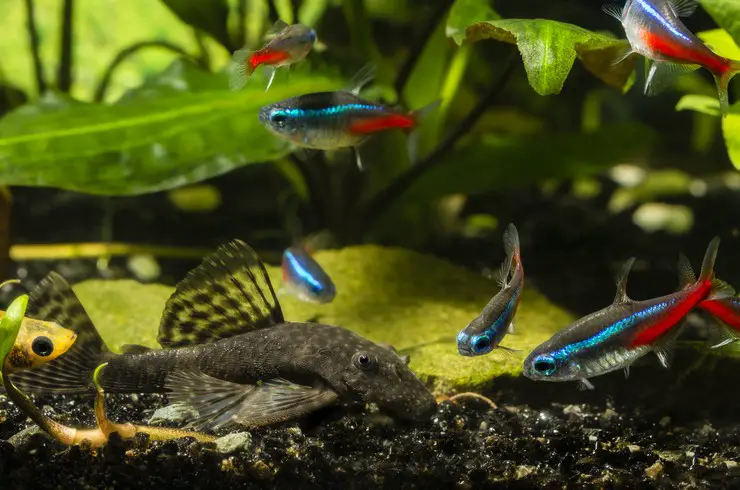
Ancistrus catfish can be kept in aquariums with live plants, provided that they receive a sufficient amount of food with a plant component. Otherwise, the delicate parts of some plants may be damaged.
Feeding ancistrus
The favorite food for ancistrus is algal growth, which very often appears on the walls of the aquarium or decorations when there is an excess of light. These fish are among the most effective aquarium cleaners. In addition, they are happy to eat the remains of food for other fish. In the event of a lack of food, ancistrus can switch to tender parts of living plants, in which they can gnaw a hole or eat it whole. In aquariums with ancistrus, it is extremely useful to have natural driftwood, nibbling them fish get cellulose necessary for comfortable digestion. Often, many aquarists feed their pets with vegetation from their table: scalded lettuce, cabbage, or zucchini. Unfortunately, this way of eating in some cases can lead to contamination of the aquarium, especially if you do not remove the remnants of food. In addition, remember that the food must be nutritious and balanced.
Tetra offers aquarists several options for complete balanced food for ancistrus and other chain mail catfish, which are in the form of sinking tablets. They immediately sink to the bottom, where they can be found by catfish, and prevent the rapid eating of food by fish swimming in the water column.
- Tetra Pleco Tablets are the staple food for all herbivorous bottom fish species. Bulky tablets quickly sink to the bottom and slowly soften, freeing the feed. If necessary, the feed can be placed in a suitable place. The tablets contain a large number of spirulina algae, which helps the catfish to maintain health and provide additional vitality.
- Tetra Pleco Veggie Wafers are dense wafers specially designed to feed chain catfish. First of all, they are convenient for scraping with a suction cup. The food retains its shape for a long time, allowing the catfish to feed. Do not muddy the water in the aquarium. In the center of the plate is a concentrate of algae and zucchini for optimal digestion of herbivorous catfish.
- Tetra Pleco Spirulina Wafers is a complete catfish food “sticky” with algae concentrate and enriched with Omega-3 acids, which support the fish’s immune system. The high fiber content contributes to comfortable digestion. Do not muddy the water.
You can feed catfish with tablets once a day before turning off the lights in the aquarium. If other fish are trying to take catfish tablets, then you can place them directly in your favorite Ancistrus hideout. The number of feeding tablets must be calculated independently, depending on the number and size of ancistrus.